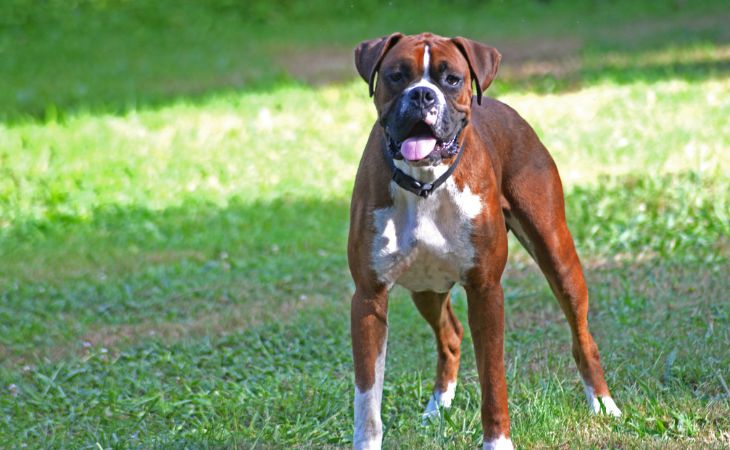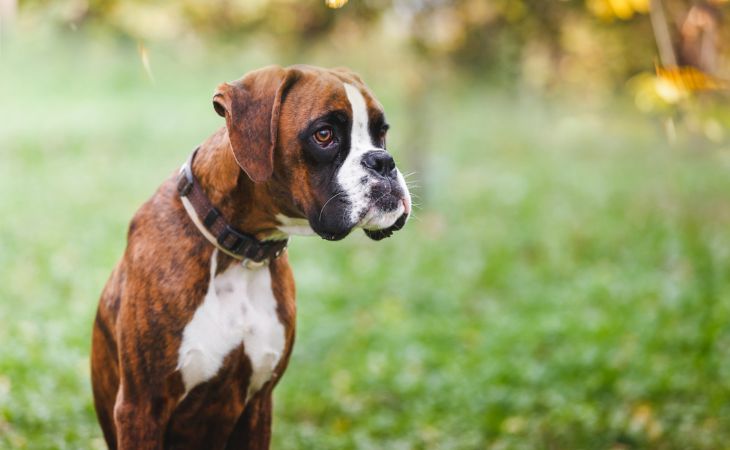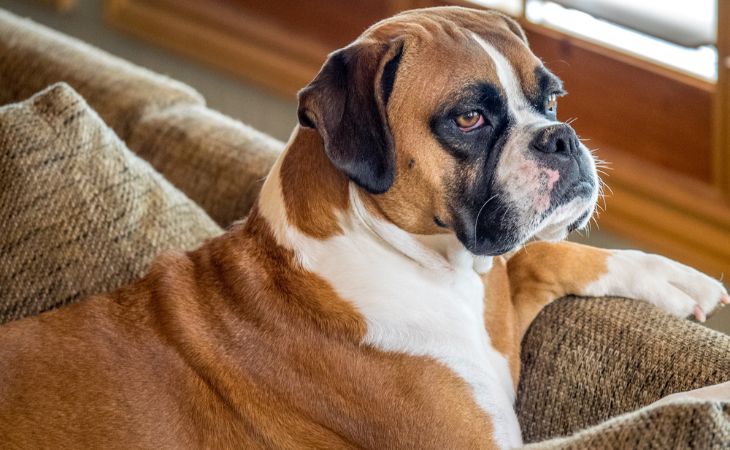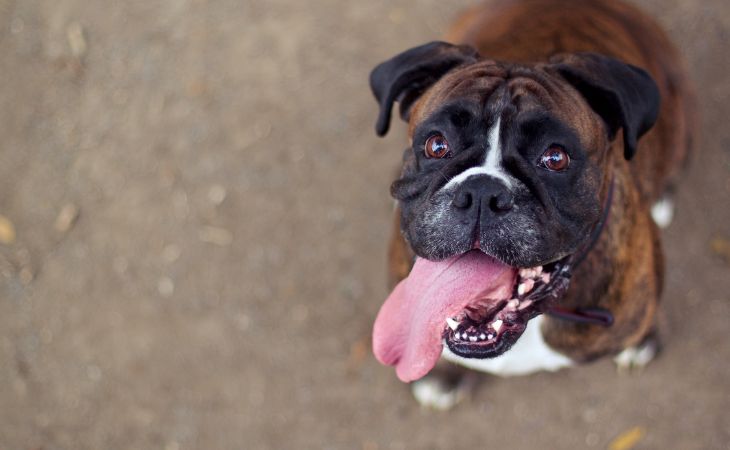Breed: Boxer I Size: Medium/large I Average lifespan: 10+ years I Temperament: Intelligent, brave, and friendly I Coat: Short I Origin: Germany.
The Boxer is easily recognizable because of its muzzle. However, this is not the only characteristic of the breed. This dog breed is dynamic and a pleasant companion.
The origins of the Boxer
A man-made breed
The first traces of the breed can be found in Germany. One of the Boxer’s ancestors, the Bullenbeisser (Brabant bull dog) was a very robust molossoid dog, which particularly appreciated for its defensive qualities. Over time, however, the breed became more unstable and aggressive. The dog breed tended to flee. Many breeders tried to recreate the original loyal, powerful and courageous breed, without its characteristic uncontrollability.
Several breeders (Friederich Roberts, Erald Konig et Rudolf Hopner) came together to try to restore the original features. They paired the Bierboxer with a female English Bulldog. By doing this, they hoped to combine the power of the Bierboxer with the determination and agility of the English Bulldog.
The first puppy, named Lechner’s Box, appeared in 1888. He was a small fawn and white male. Later, he was mated to his mother Alt’s Flora and gave birth to two offspring: Alt’s Flora II and Alt’s Schecken. Always on the lookout for the perfect dog, breeders continued their trials and in 1895 paired Schecken with a white bulldog named Dr Toneissen’s Tom. Thus, the first Boxer was born: Mühlbauer’s Flocki. He was registered as a Boxer in the German Book of Origins for dogs.
Controlled evolution
The Boxer’s ancestors were used for hunting, and their power was perfectly suitable for this purpose: fighting and defending their owner.
Research was led to stabilize this force in order to create a docile dog that was capable of reacting to defend an area or person. Their combativeness stayed an important, but it was nuanced by gentleness.
The first presentation of the new breed took place in Munich in 1895 at a meeting of the St. Bernard Club. The breed was confirmed at a second Munich show on March 29, 1896. Around fifty Boxers were shown. The first standards were ratified in 1902. A virtually definitive version saw the light of day in 1905. By 1910, numerous Boxer breeders were appearing in Germany. Little by little, the Boxer conquered the world.
Uses for which it is renowned
The Boxer joined the canine forces during the First World War, then became part of the police force in 1922. Between the wars, the breed was accepted as a public utility dog. The Boxer had considerable success and was in great demand during the Second World War. The number of offspring multiplied, and the breed was brought all over the world.
The Boxer arrived in France at the beginning of the 20th century and found its place in the United States, England, and the Netherlands starting in the 1930s.

The character of the Boxer
The origins of this breed make them excellent defense dogs, but this does not summarize them. These dogs are also friendly and kind pets.
The qualities of the Boxer
The Boxer is considered the gentlest molossoid. It is a very intelligent dog, capable of knowing when they need to be delicate and when they need to defend their owner. They like to play and exercise and can be the perfect pet for those that want to practice agility. They are full of energy and for their health, it is better to offer them opportunities when they can regularly play.
The Boxer is known as a calm breed when they are in the house. However, when outside, they like to exercise. This breed needs to let off steam during outings. In addition, they love playing with children and their owners. They can show their energy during periods of intense play. As they are serious and stable dogs, they still know how to stay well-behaved when they need to.
This is the perfect family dog. They watch over all of the members of the family with care, especially the children. In addition, these dogs are brave and self-confident. They love their owners and would do anything to protect them. It is, therefore, a loyal dog that would valiantly defend their loved ones, especially children.
What you need to know
There are advantages and disadvantages to having a Boxer. For example, while they are very energetic and excellent protectors, they can be difficult to control. Even though this breed does not present any major shortcomings, it’s important to give them excellent training and education. Let’s not forget that the breed was created for defense. Unfortunately, if they are not well-trained, they could turn out to be very dominant dogs. For this reason, it’s essential to provide them with a solid grounding from an early age.

The physical characteristics of the Boxer
General
The Boxer is a short-haired and muscular dog breed. This breed is medium-sized and is recognizable for it cube-shaped head, large muzzle, and floppy ears. This dog’s body is powerful, harmonious, and rather thin.
Head
This breed has a perfectly proportionate head. Their skull is narrow, harmoniously adapted to the rather short muzzle. The Boxer’s lower jaw is slightly more advanced than the upper. This characteristic lends the Boxer’s physique a very distinctive note. The skull is rounded and well-proportioned as well.
The ears are placed on top of the skull. They fall back with a slight fold on the head and tend to move forward. Until 2004, owners could trim the ears to a point. Nowadays, this is forbidden in France.
The Boxer’s eyes are dark. They should not be bulging and should not be too big or too small. The eyes are bordered by eyelids that are slightly darker than the coat color.
Body
The body of this breed is stocky, but well-balanced with powerful bones. When you look at a Boxer, you see a massive dog that looks strong. They have straight and sturdy legs. The back is short, ideally muscular and broad. The curves of the body are emphasized by visible musculature.
The tail is attached high and is average length.

Coat, color, and grooming
Coat
The coat is short, hard, and shiny. It is grippy and smooth to the touch.
Colors
The breed’s standards allow two colors: the most widespread, fawn, and brindle. White is not recognized, but up to one-third white is tolerated. In fact, many Boxers have a patch from head to chest.
Grooming and caring for a Boxer
Even though the Boxer has a short coat, it is important to groom this dog’s coat well. It is recommended to brush your Boxer’s coat twice a week.
The Boxer sheds during the two seasonal molts, but this remains reasonable.
To make their coat shine, you can apply chamois leather. Additionally, to nourish their coat, you can also shampoo them twice a year with a suitable shampoo.
It’s important to check your Boxer’s eyes and ears regularly and do not hesitate to clean them.
The Boxer at a glance
Size: males measure between 57 and 63 cm; females measure between 53 and 59 cm.
Weight: between 30 and 35 kg (≈ 66.1 and 77.2 lb) for males and 25 and 30 kg (≈ 55.1 and 66.1 lb) for females.
Health: The Boxer has rather fragile health. It’s important to keep an eye on several aspects. Their short muzzle can be at the origin of respiratory problems, especially during the summer season. This breed is also prone to cardiac problems, in particular aortic stenosis and cardiomyopathy.
They can also encounter joint problems, like arthritis and spondylosis and, according to its progenitors, dysplasia.
This breed can also suffer from sunburn, which can cause skin cancer. Some dogs may be allergic to pork.
Average lifespan: 10 to 12 years.
Is this breed good with children? A Boxer would be an excellent furry friend for children. This breed likes to play with children, spend time with them, and protect them. Boxers are ideal dogs for families with children.
Is the Boxer easy to train? This breed is proud and can sometimes refuse to understand their owner’s orders if they find them incoherent. To channel this breed’s energy, it’s important to provide them with firm education and training. You need to be assertive and authoritative. This dog appreciates logical commands and would be delighted to obey them.

